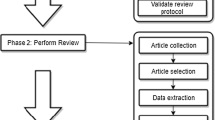Abstract
In this paper, we describe the architecture of an object-oriented scheduling system. First, a mathematical framework is presented that is based on set theory and graph theory. Then a number of basic as well as more specialized methods are defined which can be applied on the entities of any decision support system. The principal objects of a scheduling system are defined, as well as the methods specifically designed for the manipulation of the schedules. The object base design, the schedule generator design and the user interface design are then discussed in detail.
Similar content being viewed by others
References
G. Booch, Object-Oriented Analysis and Design with Application, 2nd ed., Benjamin Cummings, 1994.
A. Collinot, C. LePape and G. Pinoteau, SONIA: A knowledge-based scheduling system, Artificial Intelligence in Engineering 2(1988)86–94.
M.S. Fox and S.F. Smith, ISIS — A knowledge-based system for factory scheduling, Expert Systems 1(1984)25–49.
P. LeFrancois, M.H. Jobin and B. Montreuil, An object-oriented knowledge representation in real time scheduling, in: New Directions for Operations Research in Manufacturing, G. Fandel, Th. Gulledge and A. Jones, eds., Springer, New York, 1991, pp. 262–279.
J. Martin, Principles of Object-Oriented Analysis and Design, Prentice-Hall, Englewood Cliffs, NJ, 1993.
B. Meyer, Object-Oriented Software Construction, Prentice-Hall, Englewood Cliffs, NJ, 1988.
M. Pinedo, Scheduling: Theory, Algorithms and Systems, Prentice-Hall, Englewood Cliffs, NJ, 1995.
M. Pinedo, R. Samroengraja and B.P.-C. Yen, Design issues with regard to scheduling in manufacturing, in: Control and Dynamic Systems Vol. 60, C. Leondes, ed., Academic Press, San Diego, 1993, pp. 203–238.
J. Sauer, Dynamic scheduling knowledge for meta-scheduling, Proceedings of the 6th International Conference on Industrial Engineering Applications of Artificial Intelligence and Expert Systems (IEA/AIE), Edinburgh, Scotland, 1993.
S.F. Smith, Knowledge-based production management: Approaches, results and prospects, Production Planning and Control 3(1992)350–380.
S.F. Smith, N. Muscettola, D.C. Matthys, P.S. Ow and Y. Potvin, OPIS: An opportunistic factory scheduling system, in: Proceedings of the 3rd International Conference on Industrial and Expert Systems (IEA/AIE 90), Charleston, SC, 1990.
S.F. Smith and O. Lassila, Configurable systems for reactive production management, in: Knowledge-Based Reactive Scheduling (B-15), E. Szelke and R.M. Kerr, eds., Elsevier Science, North-Holland, 1994, pp. 93–106.
I.W. Woerner and E. Biefeld, Hypertext-based design of a user interface for scheduling, in: Proceedings of the AIAA Computing in Aerospace 9, San Diego, CA, 1994.
B.P.-C. Yen, On the architecture of object-oriented scheduling systems, Ph.D Thesis, Department of Industrial Engineering and Operations Research, Columbia University, New York, NY, 1995.
E. Yourdon, Object-Oriented System Design: An Integrated Approach, Prentice-Hall, Englewood Cliffs, NJ, 1994.
Rights and permissions
About this article
Cite this article
Pinedo, M., Yen, B.PC. On the design and development of object-oriented scheduling systems. Annals of Operations Research 70, 359–378 (1997). https://doi.org/10.1023/A:1018986524234
Issue Date:
DOI: https://doi.org/10.1023/A:1018986524234




